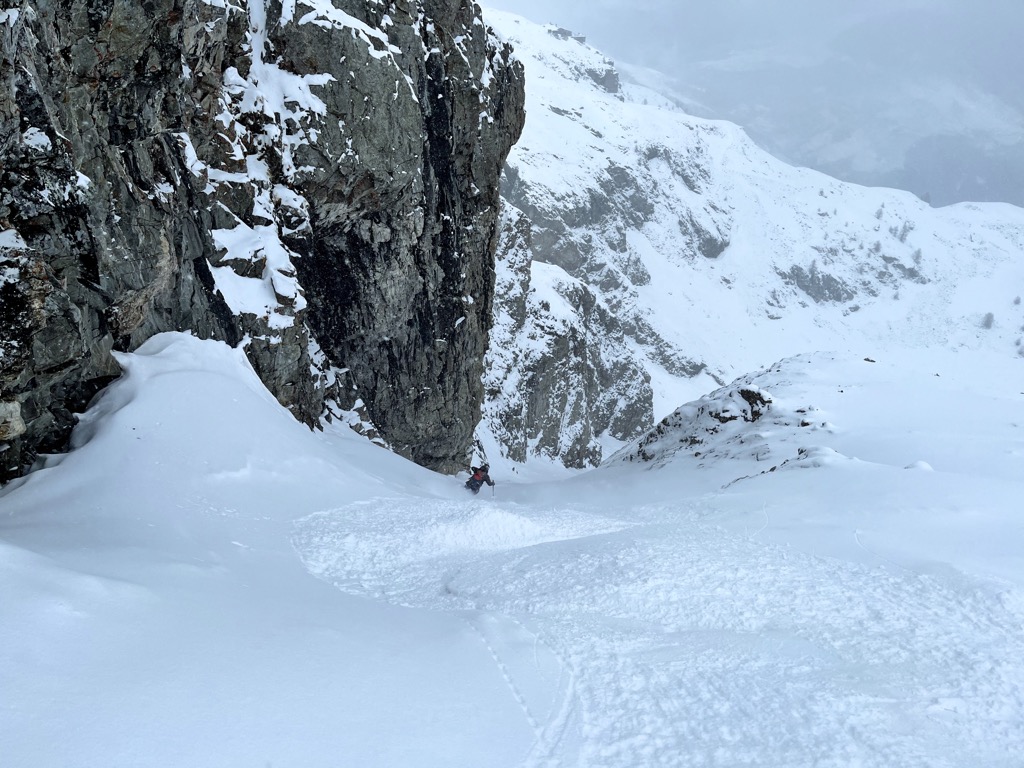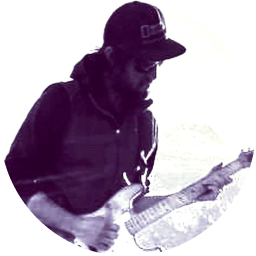Snow is one of the wonders of our world. Our discussion of snow, off-piste skiing, and untracked powder will give you new insight into finding the best conditions on any given day in the mountains. Because snow is so multi-faceted, this article explores many things, from the mountains’ terrain, weather, and climate to the unparalleled joy of powder skiing.
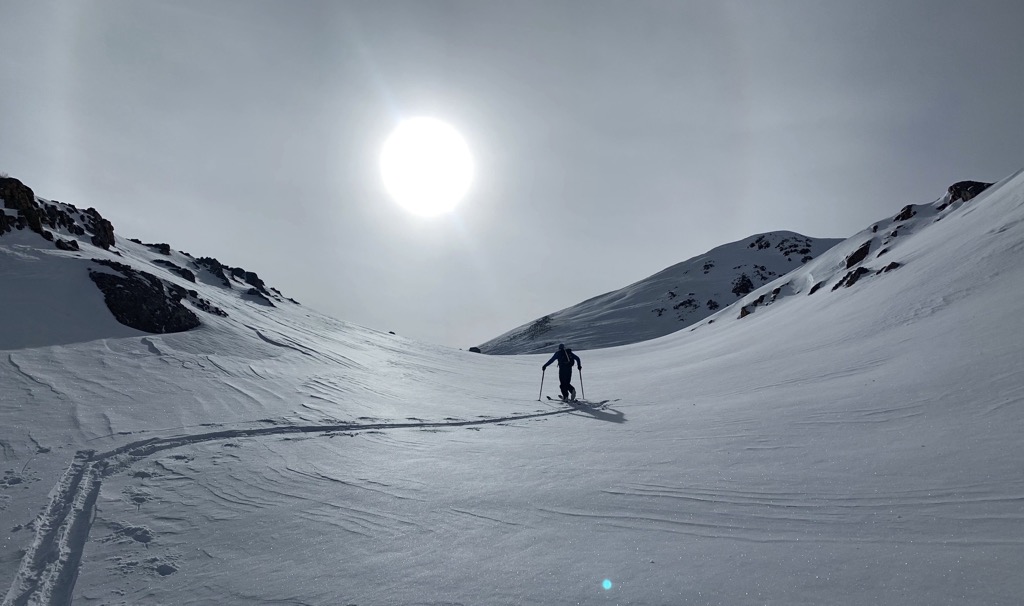
An Ode to Snow
As a young boy, I remember learning that Inuit Peoples had hundreds of names for snow, which arose from necessity; they lived in a world of snow and ice. Personally, I loved snow, and I liked the idea that there were people out there who could have so many names for it.
I couldn’t have guessed that, decades later, I would have nearly as many names for snow in my own vocabulary. As a skier, I regularly communicate using many words for snow, including but not limited to cold smoke, goose feathers, bottomless, bouncy, blower, pillows, puff, fluff, smooth, un-tracked, mank, cement, slush, hardpack, skier-compacted, winter snow, re-freeze, transform, sun-affected, sun-cupped, spring snow, corn, graupel, dusting, refresh, roller balls, slabby, pizza boxes, cream cheese, mashed potatoes, wind-compacted, wind-buff, wind-board, wind crust, sun-crust, breakable crust, supportive crust, regular crust, firm, soft, chatter, grabby, chunder, chop, sastrugi, boilerplate, avy debris, chalk, machine-groomed, scoured, light, heavy, edgeable, not-edgeable, hoarfrost, depth-hoar, facets, surface hoar, sugar, rime-ice, and slough…to name just a few.
Incredibly, I use each and every one of those words countless times during the season to describe what's going on out there to my friends and anybody else willing to listen.
Nevertheless, not all types of snow are created equally. Some are simply better than others. A LOT better. And the greatest of all is…POWDER. The word comes out of a skier's mouth more often than any other. If it’s good out there, it’s likely because it’s a powder day. If it’s terrible, skiers will lament that they wish it were a powder day. If only we could get some powder! Powder to the people! It’s the holy grail of skiing and the reason why many people have dedicated their lives to this sport.
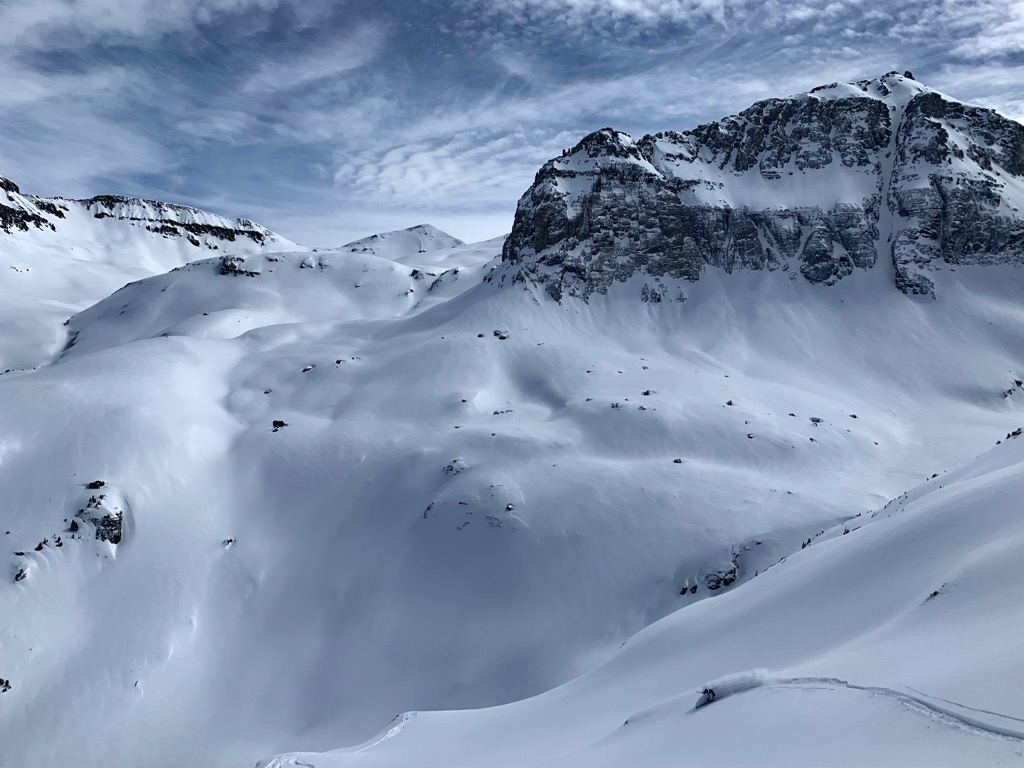
Skiing Off-Piste
What Exactly is Off-Piste Skiing?
Piste is a French word that roughly translates to ‘track’ in English. In the context of skiing, it generally refers to any groomed ski trail. Everything outside of the groomed areas is off-piste.
By definition, only nature and skiers influence off-piste terrain. There may be evidence of skiers, such as moguls, but there won’t be grooming or snowmaking. Some skiers would argue that landscaping the runs, such as cutting trees and mowing brush, constitutes preparation and is not true off-piste skiing, even if there is no snowmaking or grooming.
Therefore, off-piste skiing is skiing the natural mountain. All those types of snow I mentioned in the introduction? You will encounter all of them skiing off-piste. You will also discover natural features like rocks, ridges, bowls, couloirs, glaciers, cliffs, trees, and streams.
You will likely find life-changing happiness in this environment. But it’s essential to be aware of hazards, of which there are many. Stepping away from the groomers requires vigilance and accepting a certain level of risk.
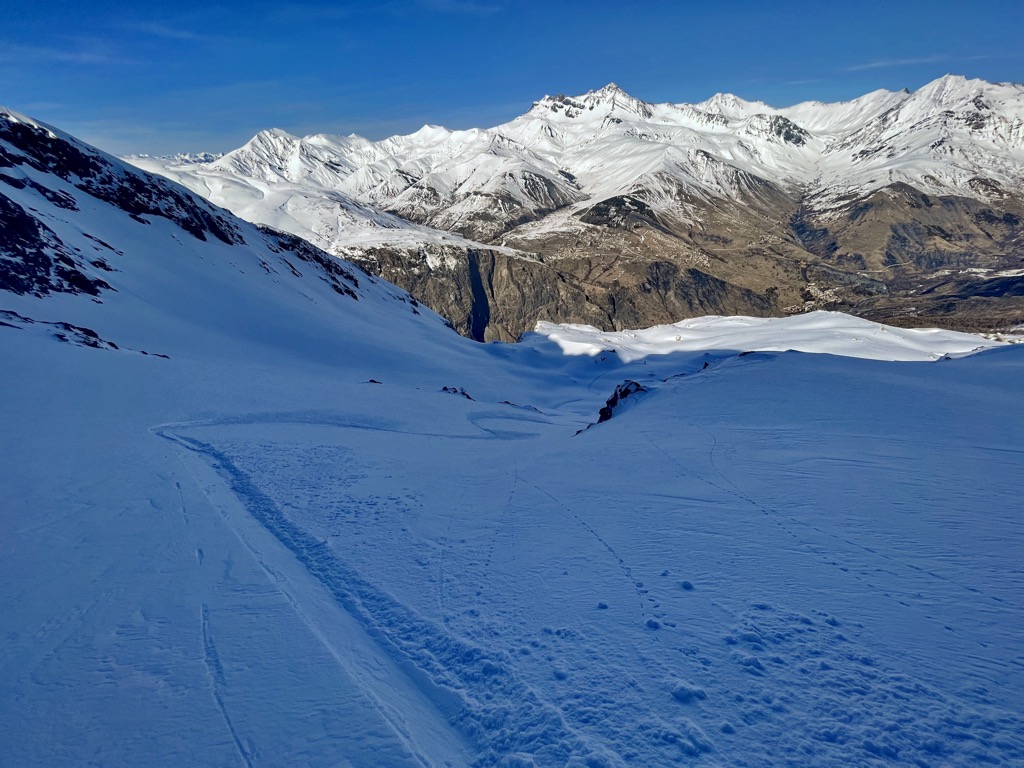
Where to Start
Skiing is an incredible sport. You can’t compare the joy and simplicity of riding up a chairlift in the mountains, only to slide down on snow using slippery wooden sticks attached to your feet.
As we begin skiing, we fall, struggle to stand, twist, turn, and eventually carve our way down the piste. That’s usually where the off-piste comes into play. As the next step in skiing, it is consistent with the appetite for discovery that defines humankind.
Many off-piste skiers couldn’t be bothered to ski a piste ever again, which is understandable. Still, the piste is the perfect setting for skiers to learn. It’s relatively safe and is the best place to learn to carve, the most crucial technique in skiing. Carving is the manipulation of a ski’s edges to “grab hold” of the snow and execute a turn. Here is my general outline for a skier's progression into an off-piste skier.
- Learning to stand, snowplow, french fry, and, eventually, carve on-piste.
- Experiencing a variety of conditions on-piste, i.e., scraped, icy pistes or end-of-the-day pistes with moguls.
- Tackling ungroomed sections on the side of the piste or skiing short areas of off-piste between the pistes.
- Skiing mellow off-piste or tree sections at a resort.
- Skiing everything on your home mountain.
- Skiing in the backcountry - the true off-piste.
Plenty of skiers won’t follow this progression. Some prefer to stay on the slopes. Plenty of kids will rapidly progress and spend all their time in the snow park. Some folks will always stick to mellow terrain. And many skiers will choose to never ski in unpatrolled terrain, i.e., the backcountry. This article is written for the fraction of skiers who will become interested in off-piste skiing, on and off the resorts.
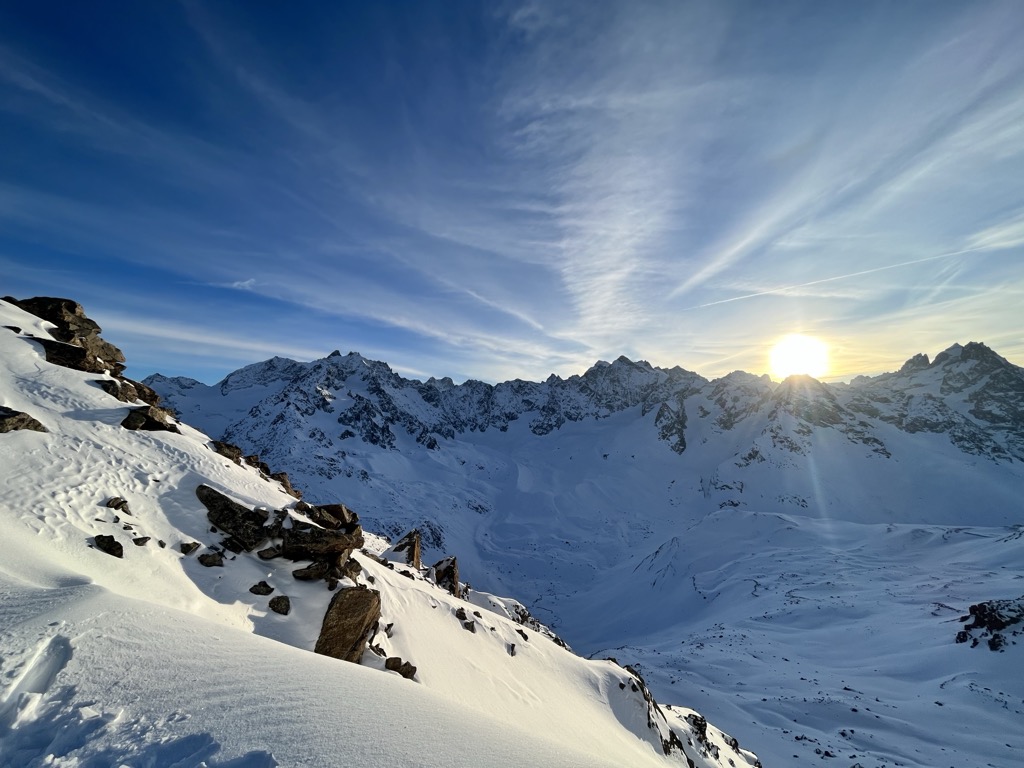
Sniffing Out the Best Snow for Off-Piste Skiing
Whereas the prepared, groomed pistes offer a relatively consistent skiing surface, off-piste snow can span the spectrum from dangerously bad (icy, frozen avy debris/roller balls) to life-changingly good (deep, light powder). Here are some tips to find the best snow.
Lose the Paper Cartoon Map (And Check out PeakVisor)
You remember those cartoon maps you would use to figure out the pistes at a resort? Well, those aren’t much use when it comes to discerning the nuances of off-piste terrain. Advanced 3D Maps, such as PeakVisor’s Mobile App, have replaced these illustrations.
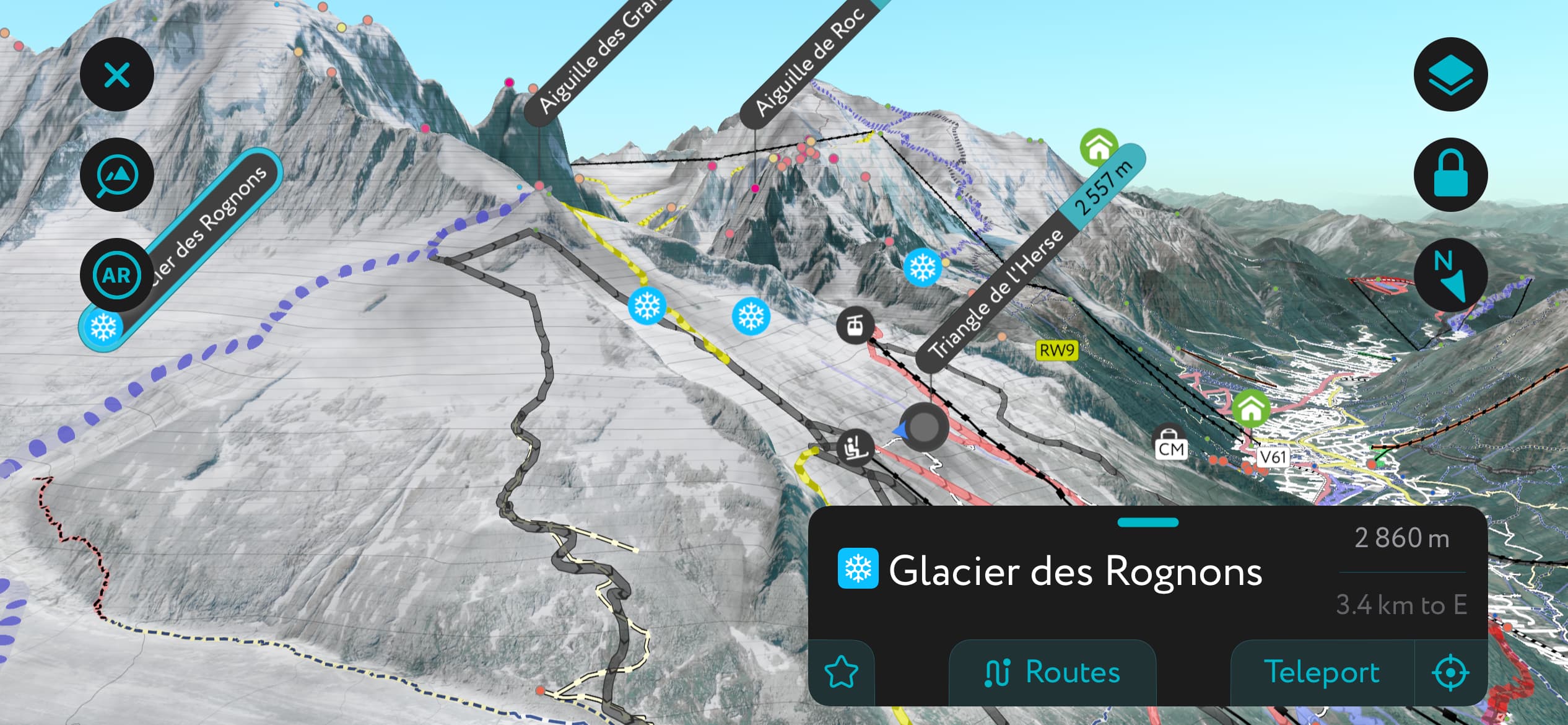
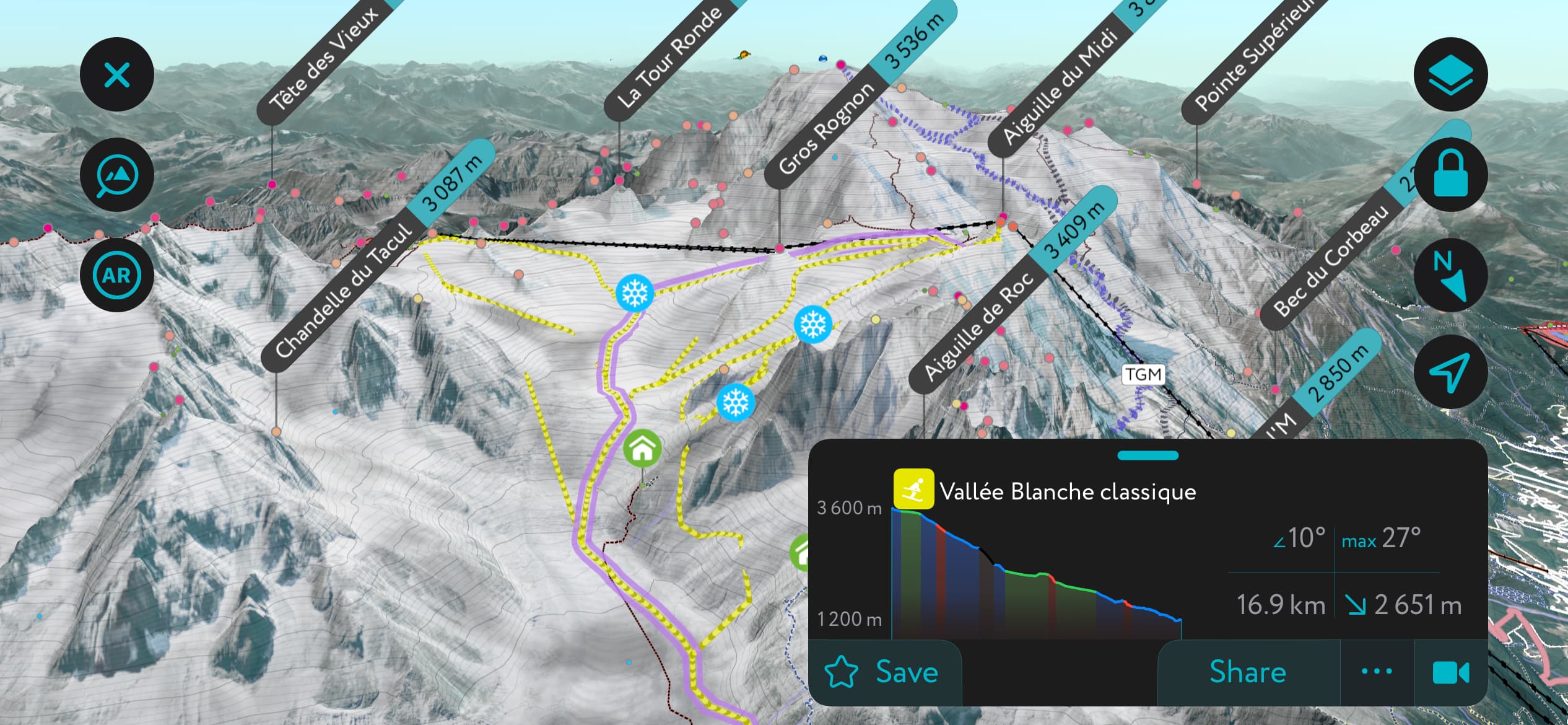
Aspect - Be Aware of the Sun
Generally speaking, the softest snow is the best snow. The sun is one of the most crucial factors in determining how soft snow will be after a storm. During the winter, we want to seek out sections of terrain that receive less sun. That’s why nearly all ski resorts face some variation of north, i.e., northeast, northwest, etc. These aspects receive less sun and, therefore, hold a deeper, softer snowpack. These directions are backward in the Southern Hemisphere; the south is shady while the north receives more sun.
- Slopes that don’t receive sun can hold powder for a week or more after a storm if the temperatures stay cold. Meanwhile, south-facing slopes become sun-affected and crusty after just a day or two, even if it is cold.
- In the spring, we can start seeking out sun-drenched slopes for the best skiing. Snow will soften in the sun’s rays and provide skiers with wonderfully soft and slushy turns, often called corn, transform, or spring snow.
- The best aspect will often shift throughout the day. East-facing slopes, which get morning sun, may soften earlier while west-facing slopes receive sun later (unlike north and south, east and west are not reversed in the Southern Hemisphere). North-facing slopes, which may offer the best powder snow, might not get enough sun for good spring skiing.
The best way to learn is to ski around as much as possible and observe how the conditions respond to the sun on different aspects of the mountain.
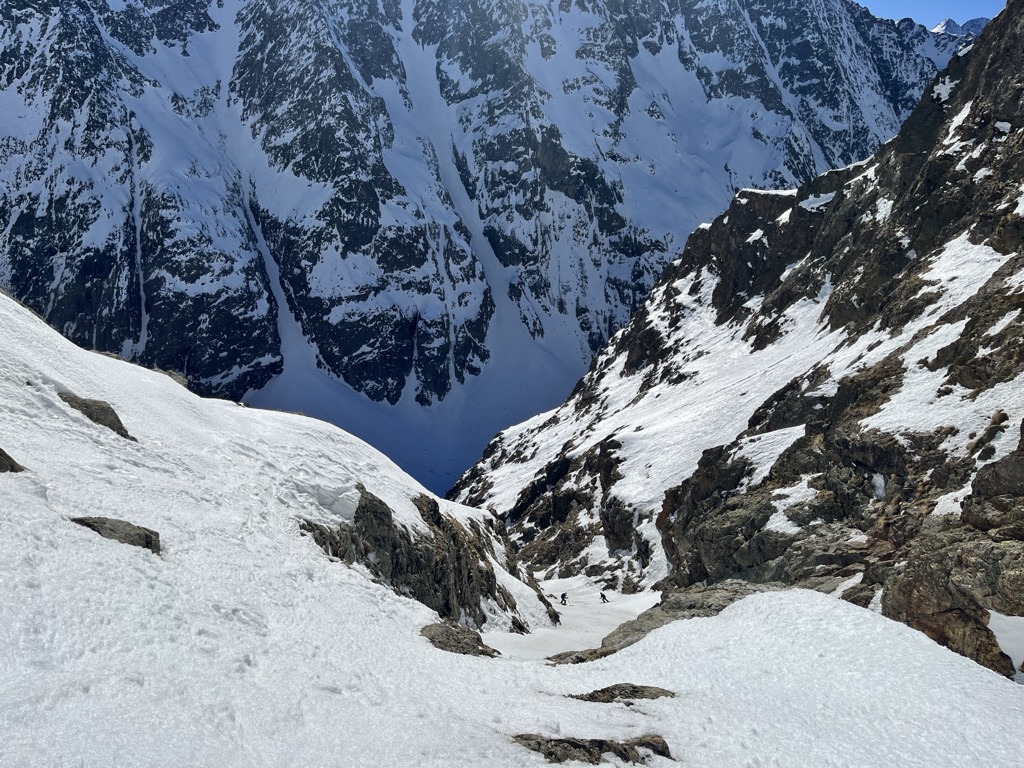
Wind
Wind can do many different things to snow, and it’s hard to predict what the conditions will be like. Serious off-piste skiers often monitor wind speeds and gusts through alpine weather stations.
- Strong winds are almost always bad for snow conditions for several reasons. I’ve seen windstorms blow much of a season’s snowpack clean off the mountain. Wind removes snow from ridges first, though truly destructive winds can also clean out open faces and bowls. Strong winds often create a crusty layer on top of the snow called a wind-crust or wind-board. When this crust is breakable, it is nearly impossible to ski well. Winds also contribute to avalanche conditions by forming massive, cohesive slabs of snow. When a skier finds a trigger point, these slabs can suddenly release a tremendous amount of snow at once. Because winds transport large amounts of snow, this can occur without much fresh snow falling from the sky.
- Moderate winds often create decent snow conditions on certain aspects. Wind will compress and smooth out the top layer of snow, creating a surprisingly enjoyable ski surface. Skiers call this “wind-buff” or “cream cheese.” When the layer is particularly bouncy, I’ve heard skiers describe it as a “dancefloor.” Wind-buff days are some of the best because your tracks get erased during the chairlift, and you ski a flat snow surface all day.
- Wind can transport a lot of snow, and wind direction often determines what parts of the mountain get the most snow. For example, a northwest-facing bowl may do well with winds from the northwest; the terrain literally “catches” the snow like a giant satellite dish picking up a signal.
Temperature
Generally speaking, we want colder temperatures to enjoy the best snow. Temperatures between -4 and -18℃ (25 and 0℉) are ideal. The snow can become like styrofoam and stick to the bottom of your skis if it gets colder. Conversely, warmer temperatures will cause snow crystals to collapse and consolidate, especially if the snow sees the sun during the day.
During a storm, the best snow falls with temperatures between -10 and -15℃ (15 and 5℉) with little to no wind. A special snowflake known as a stellar dendrite will form in these conditions. These crystals have a large, well-defined structure and pile up on the ground with lots of air between them, creating super light powder. Sometimes, 2.5 cm of liquid can add up to 60 or 70 cm of snowfall (1:25 ratio in inches). The crystals won’t form if it’s too warm or cold, and the wind knocks crystals into each other, breaking them apart.
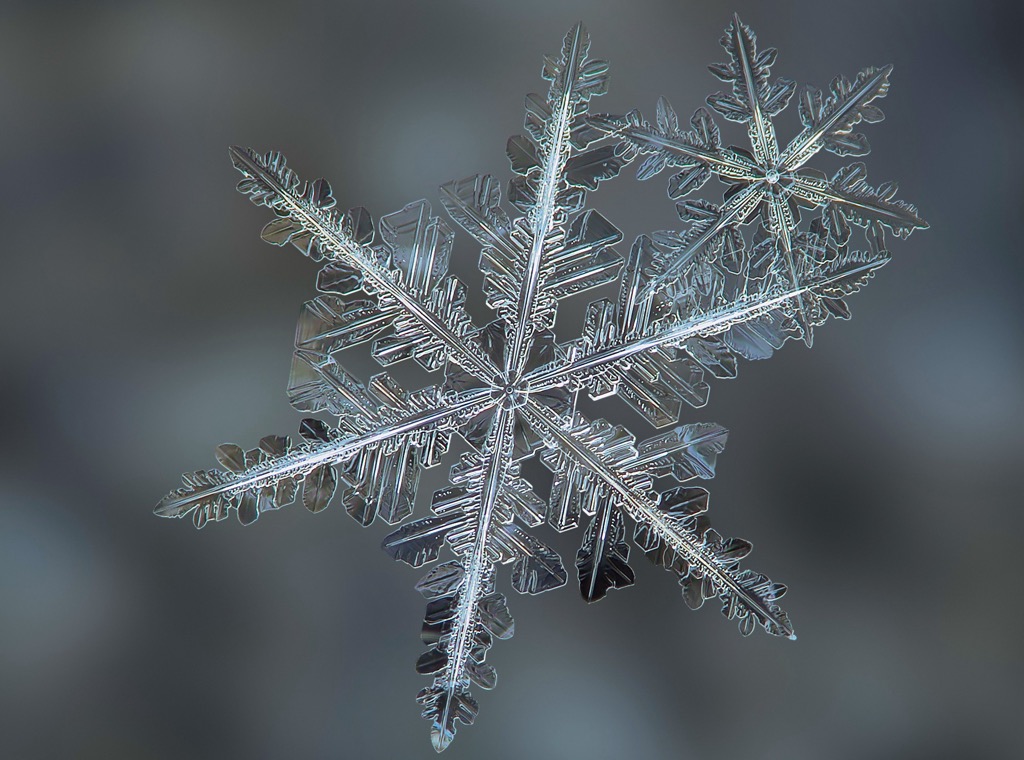
Humidity
The best quality snow falls in drier environments, while humid environments tend to get heavier, less desirable snow. However, more humidity often means a climate with more snow.
- Dry, cold air is the best for high-quality, light powder. Colder air is inherently more dry because cold air holds less moisture. The best snow conditions occur when wetter, heavier snow falls at the beginning of a storm and drier, lighter snow falls at the end. Skiers affectionately call this “right-side-up” snowfall. The thick base means you float on top of old snow layers, giving the skiing a “bottomless” sensation. Meanwhile, the lighter snow on top is playful and effortless to ski through. Right-side-up storms are also much safer from an avalanche perspective.
- Frequently, a cold, dry night can “suck up” some of the moisture from the top few centimeters of the snowpack. We don’t want all our snow to evaporate into the air like this, but it helps with a right-side-up storm and makes the skiing surprisingly good, even if the snow initially fell a bit wet.
- This phenomenon makes Alaska the world’s most iconic big-mountain ski destination. Snow falls wet from Pacific storms and sticks to even the steepest surfaces, forming the legendary spines we’ve all seen in ski movies. Then, cold arctic air blows in and dries everything out, making for epic powder skiing conditions.
- Coastal zones, like the Pacific Northwest of the USA, get massive amounts of snow. However, the high humidity and moderate temperature often mean that the snow can become too heavy to ski by the end of the one day after a storm.
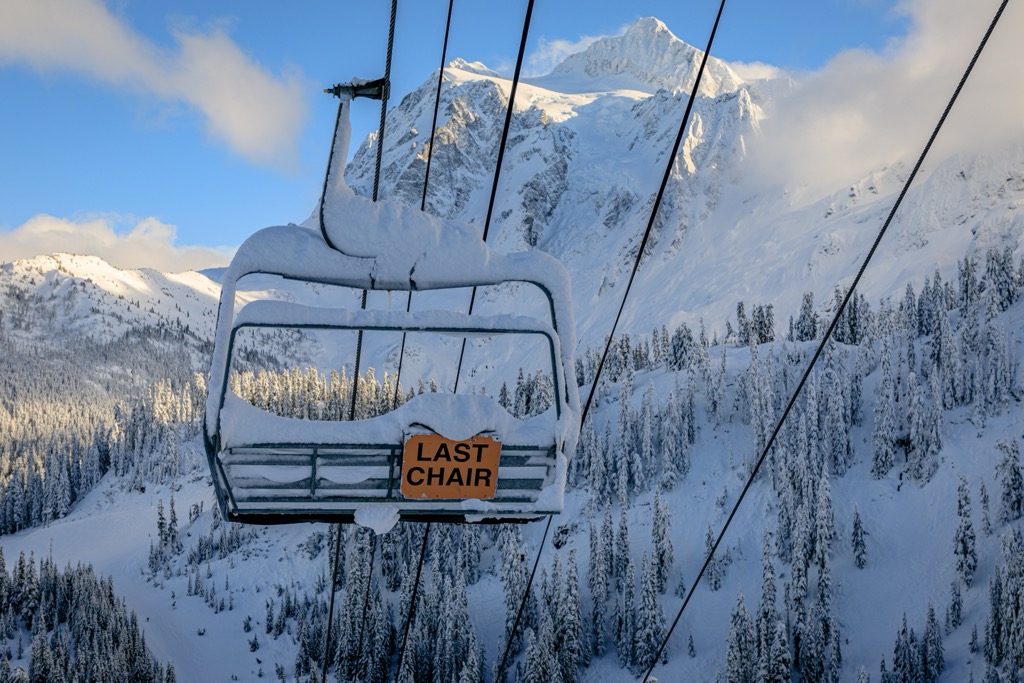
Pitch
In off-piste skiing, the pitch refers to a slope’s steepness. Many skiers don’t appreciate how much a slope’s pitch influences snow conditions.
- On steep pitches, the sun angle is less direct than on mellower slopes, and they often hold soft snow longer.
- Conversely, skiers tend to push snow down to the bottom of steep pitches, leaving old crusty snow. Moreover, snow can naturally slide off these pitches before a skier even touches it.
- Steeper pitches, particularly those in the 30-45° range, are the sweet spot for avalanches. Slopes over 45 usually slide by themselves, and if they don’t, they are (usually) stable enough to support the weight of a skier.
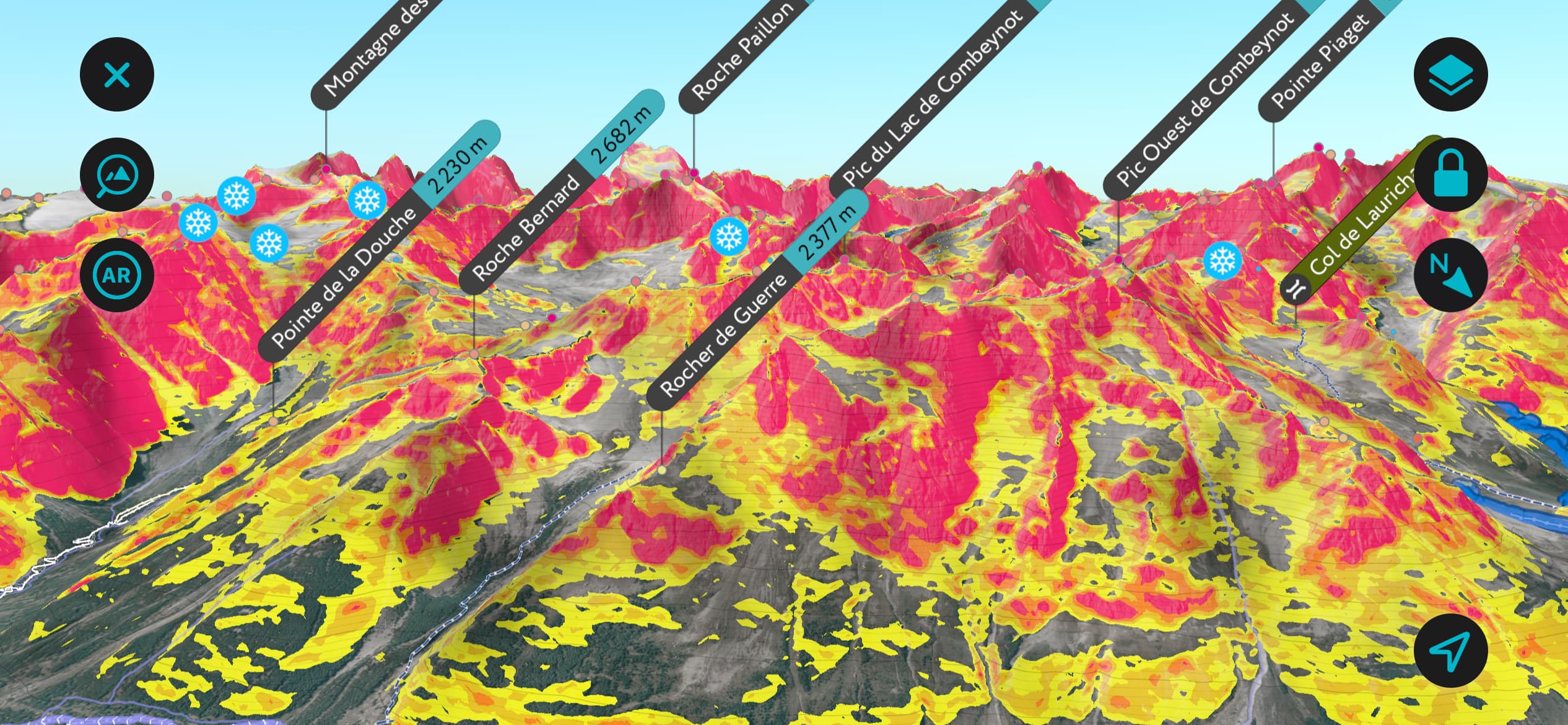
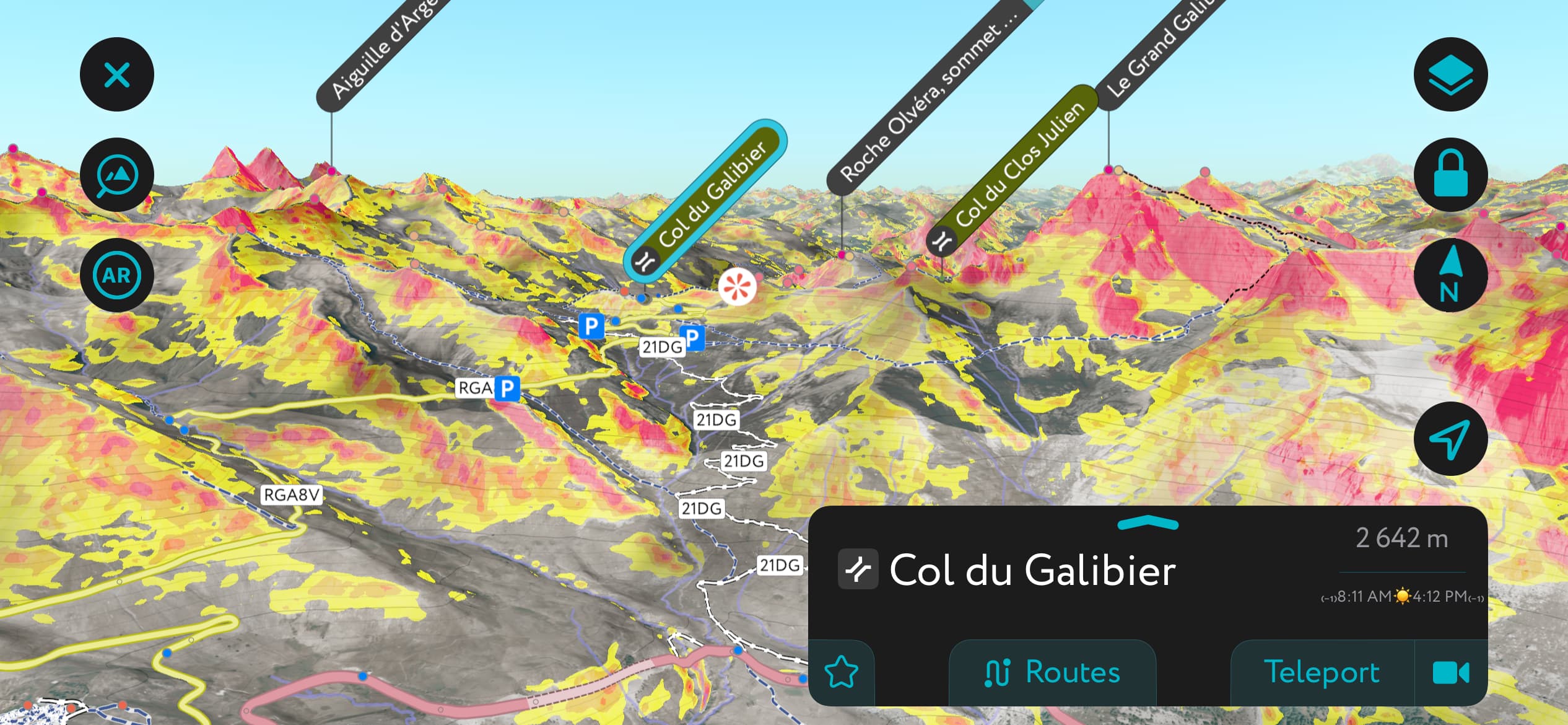
Terrain Features
Knowing the various terrain features of the mountains is crucial for finding the best snow and staying safe.
Bowls
Bowls are a powder skier's favorite terrain feature. A bowl is a depression in the side of a mountain formed over time by the formation and movement of glaciers. These features have a convex shape, like an amphitheater. Another more scientific term is a cirque.
Because they are depressions surrounded by elevated terrain, bowls catch a lot of snow. Winds blow over ridges and deposit snow into the bowl. Meanwhile, the middle of a bowl is often protected from the wind.
Bowls are usually steeper at the top, sometimes called a headwall, then mellow out at the bottom. Some bowls still have glaciers living in them.
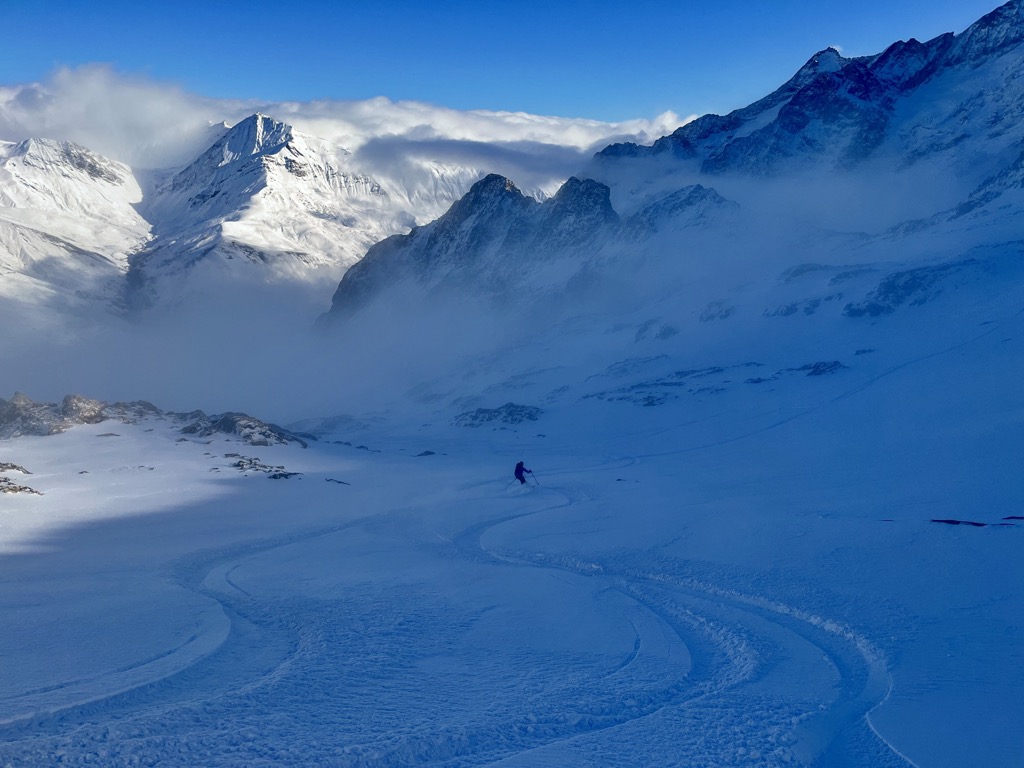
Glaciers
Glaciers are the home of some of the world’s finest powder skiing. First of all, glaciers form in areas of the mountain that catch a lot of snow, like bowls, so conditions are often deep. Secondly, glacier skiing is often high quality because cold temperatures from the underlying ice “refrigerate” the powder snow above. Additionally, a glacier usually has a deep snowpack and few obstacles, allowing skiers to open up their turns without worrying about hitting something underfoot.
The European Alps are known to have the world’s best lift access to glacier skiing. Vast glaciers exist in many places worldwide but don’t feature the convenient lift access of Europe.
Most alpine terrain, including bowls and glaciers, is challenging to ski during storms or whiteouts. There’s nothing to give you contrast against the white, which can be dangerous in some big European resorts if you lose your way.
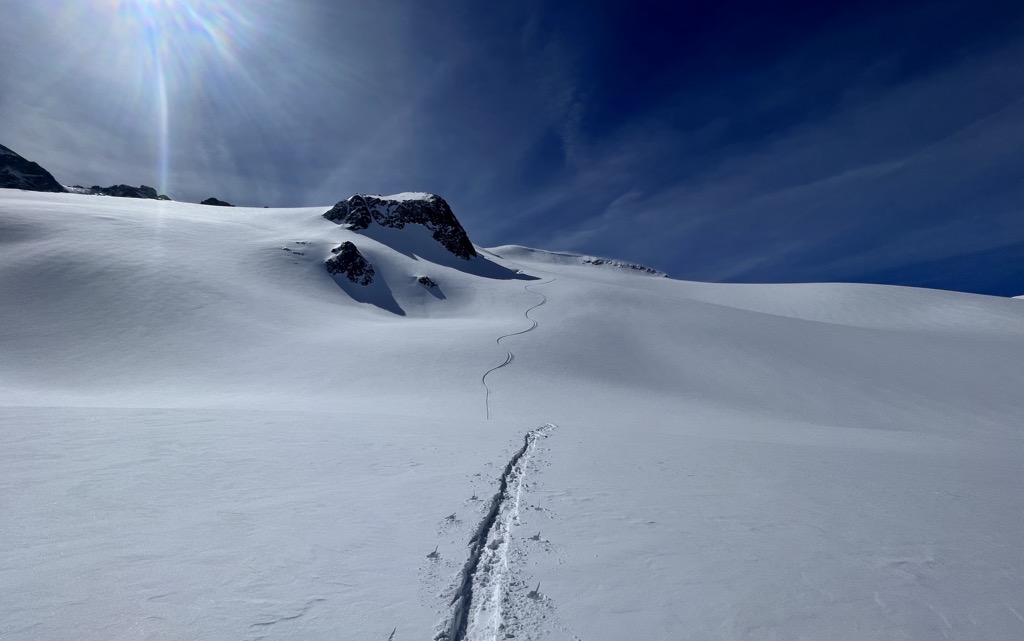
Couloirs
Couloirs are a favorite terrain feature of expert off-piste skiers. Couloir means “corridor” in French. Couloirs in the mountains are snow gullies that resemble giant hallways, thus the name.
These gullies provide some of the world’s most legendary ski descents. They are steep and aesthetic. Couloirs are often protected from the wind and collect inordinate amounts of deep powder. Nothing compares to the feeling of descending powder snow down one of these hallways of the Gods.
Couloirs are the alpine feature that is most navigable during a storm or low-visibility day. However, couloirs are not commonly accessible directly from ski lifts.
Be aware that couloirs are natural drainage pathways of the mountains that can be subject to avalanches.
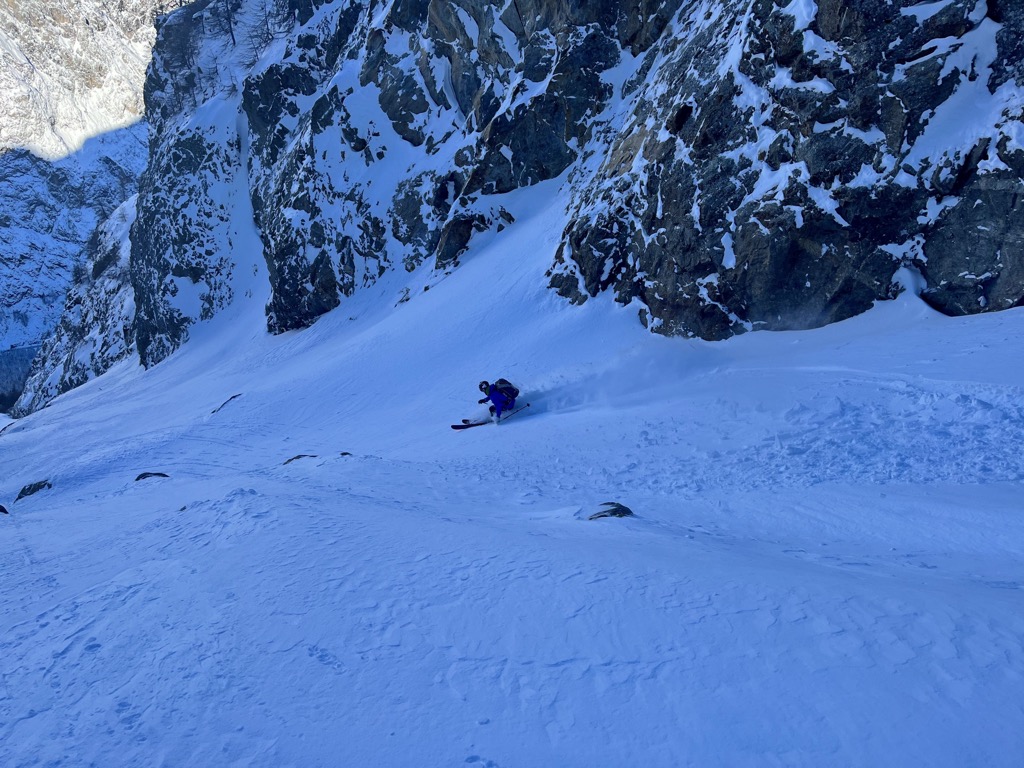
Ridges
Ridges are the opposite of all the above features in that they don’t collect snow. The wind blows snow over ridges and deposits it in depressions in between.
That said, ridges can offer an advantage regarding shelter from avalanches, which flow through depressions. Moreover, spines, a type of knife-edge ridge formed from snow, are one of the world’s most exciting ski features.
Trees
Trees. Once you start skiing the trees, you’ll realize that trees exist to be skied, specifically in deep powder. Many skiers who don’t ski alpine features like glaciers and couloirs enjoy skiing the trees. Avalanche risk is generally much lower below treeline, nor are there any crevasses.
Trees are great for storm days because they provide contrast and allow you to see when the alpine is a complete whiteout. Trees block the wind, and the snow that falls here is often lighter due to being less wind-affected.
The US, Canada, and Japan are the top places to find tree skiing. Europe has many old forests with well-spaced trees, and great days materialize, but these days, it’s often too warm below treeline for the conditions to be good.
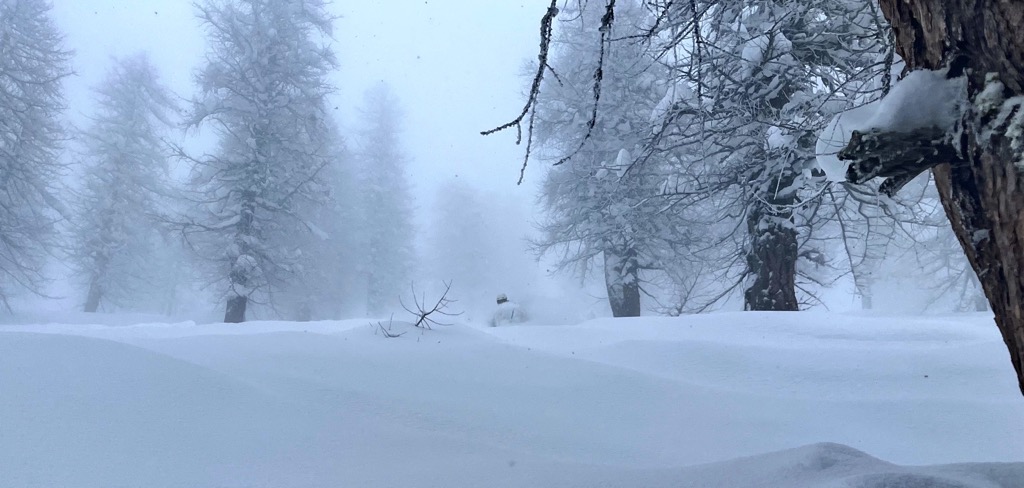
The Bliss of Off-Piste Powder Skiing
Powder skiing is one of the most extraordinary experiences this modern life has to offer. Ski pioneer, alpinist, and philosopher Dolores LaChapelle provides us with this quote:
“Powder snow skiing is not fun. It is life, fully lived, life lived in a blaze of reality. What we experience in powder is the original human self, which lies deeply inside each of us, still undamaged in spite of what our present culture tries to do to us. Once experienced, this kind of living is recognized as the only way to live — fully aware of the earth and the sky and the gods and you, the mortal, playing among them.”
Skiing in untracked, deep powder snow is the experience of flowing in several directions simultaneously. You’re going downhill, turning side-to-side, and bobbing up and down within the snow like a dolphin.
Then there’s the silence. The snow mutes sound; the hiss of your skis and the splash of snow hitting you in the face as you turn resonate like Gregorian chants in a cathedral. The bone-rattling chatter of machine-groomed snow becomes an abstraction.
Because she has described powder skiing more beautifully than anyone, I’ll leave you with one more LaChapelle quote to ponder:
“One can never be bored by powder skiing because it is a special gift of the relationship between earth and sky. It only comes in sufficient amounts in particular places, at certain times on this earth; it lasts only a limited amount of time before sun and wind changes it. People devote their whole lives to it for the pleasure of being so purely played by gravity and snow.”
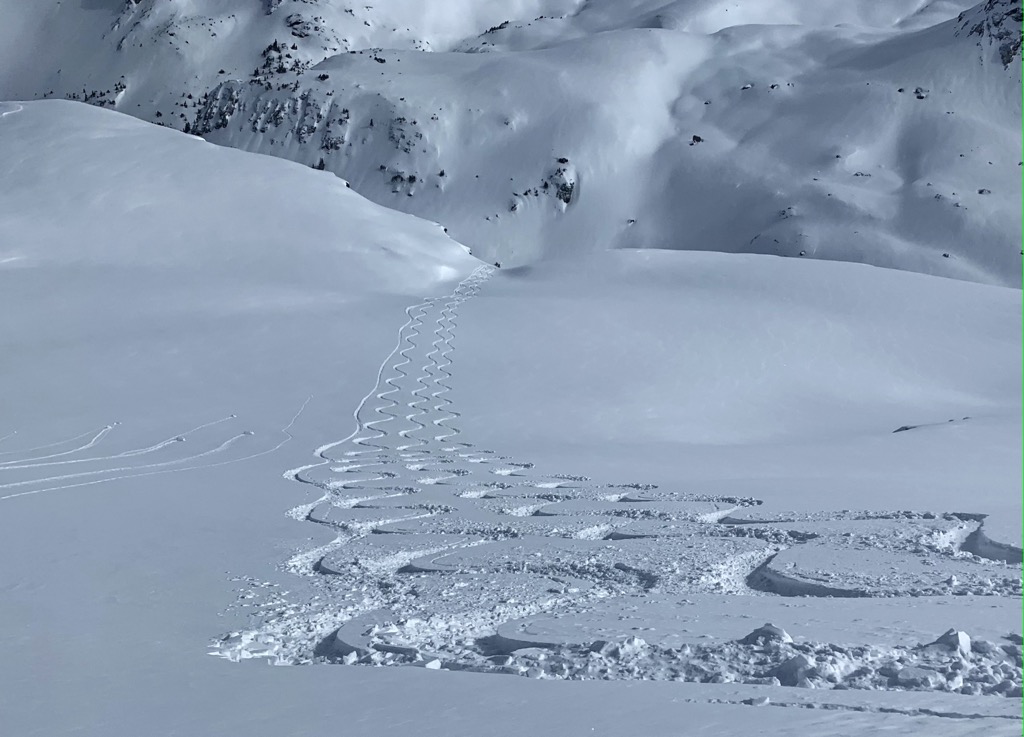
Tracking Down Fresh Tracks
We’ve covered the basics regarding off-piste snow conditions and terrain features. The good news is that it’s relatively easy to find decent snow off-piste. The bad news is that it is much more challenging to ski all these features on powder snow before anybody else, which is the holy grail of off-piste skiing.
Once you ski fresh, untracked snow, you will understand its superiority in the realm of ski experiences. Skiing untracked snow transcends the mere sport of skiing, opening up a new, aesthetic world where you are painting the canvas of the mountain. Untethered and unobstructed by the regurgitated snow of previous skiers, a skier can achieve something closer to pure freedom.
Many skiers have come to appreciate this experience more than any other. They will start earlier than you, traverse faster than you, outstrategize you… basically, they will try to outdo you in the race for powder in any way they can.
Ultimately, years of experience is required to learn the ropes. Nevertheless, here are a few basic tips to get you started.
Tracking Weather and Ski Conditions
Following weather patterns is essential in choosing the best ski days. Skiing is a unique sport in that the best days are 100 times better than the worst days, especially when it comes to off-piste skiing.
I know this isn’t possible for many people, but I would recommend NOT booking a ski vacation months in advance for off-piste skiers. There’s just no way to predict whether the skiing will be any good. Keep an eye on the snow conditions. Downsize your accommodations to places like hostels, where you can more likely book at the last minute.
Here are a few of my favorite sources to track the weather:
- OpenSnow: These guys started in Colorado and now have regionally tailored forecasts and weather discussions for the U.S., Canada, Europe, and South America. You don’t have to buy the pro version to read the discussions.
- WePowder: The European version of OpenSnow with weather discussions and “Powder Alert” updates for Europe. They only do discussions and forecasts for the European Alps.
- Tropical Tidbits: This one is for the weather geeks. Here, you can run all the major weather models on your computer to get an immersive view of the forecast.
Tracking conditions is more challenging if you’re not at the mountain skiing regularly. Webcams are a useful tool. Most resorts have a couple of them throughout the ski area. Automated weather stations are also handy. This data is a bit trickier to find. Some resorts will have links to weather stations on the resort. Some avalanche centers will link to them as well. You’ll have to dig around on the Google machine.
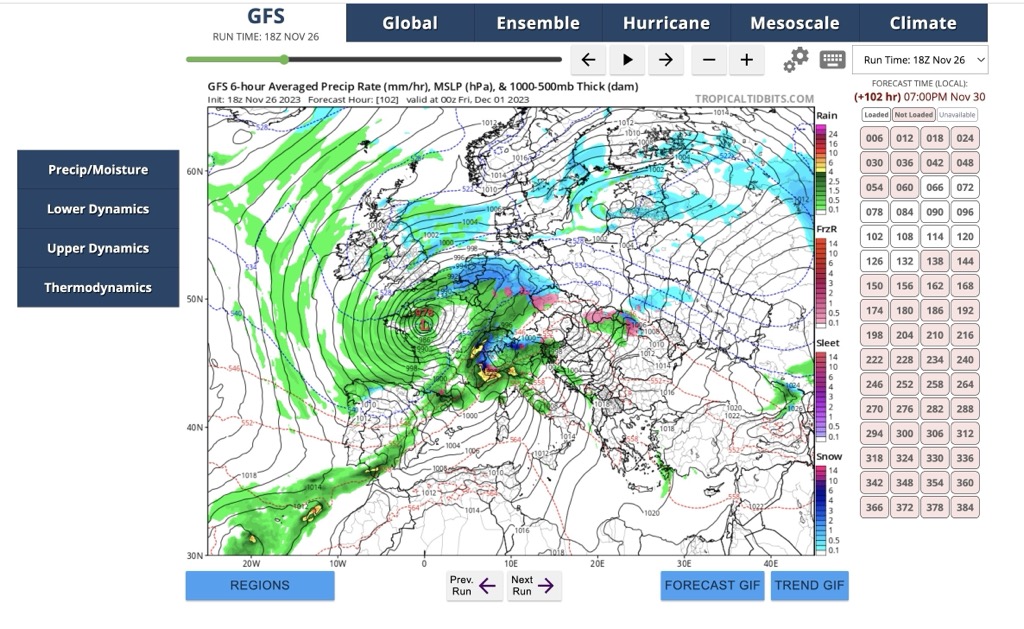
Find a Local
If you’re reading this article, you are obviously interested in off-piste skiing. However, you probably don’t live at a ski resort. Wherever there are lifts, there are locals who have been skiing them 100 days per year for decades. Try befriending one and having them show you around.
Some locals won’t show you their secret stashes under any circumstances. But I’ve found that the majority are willing for you to tag along if they think you’re a positive contribution to the community. There’s a pretty simple formula to follow:
- Don’t be a rude tourist.
- Don’t be an arrogant tourist. Don’t overhype your skills.
- Be a friendly tourist.
- Try to be in shape and be a decent skier.
If you behave like a genuine human being and not an annoying tourist, you may find a friend to let you tag along for the day.
To quote the adage, what goes around comes around. Another tip is to show people around your home resort in the hopes that, someday in the future, they will reciprocate at their home resort.
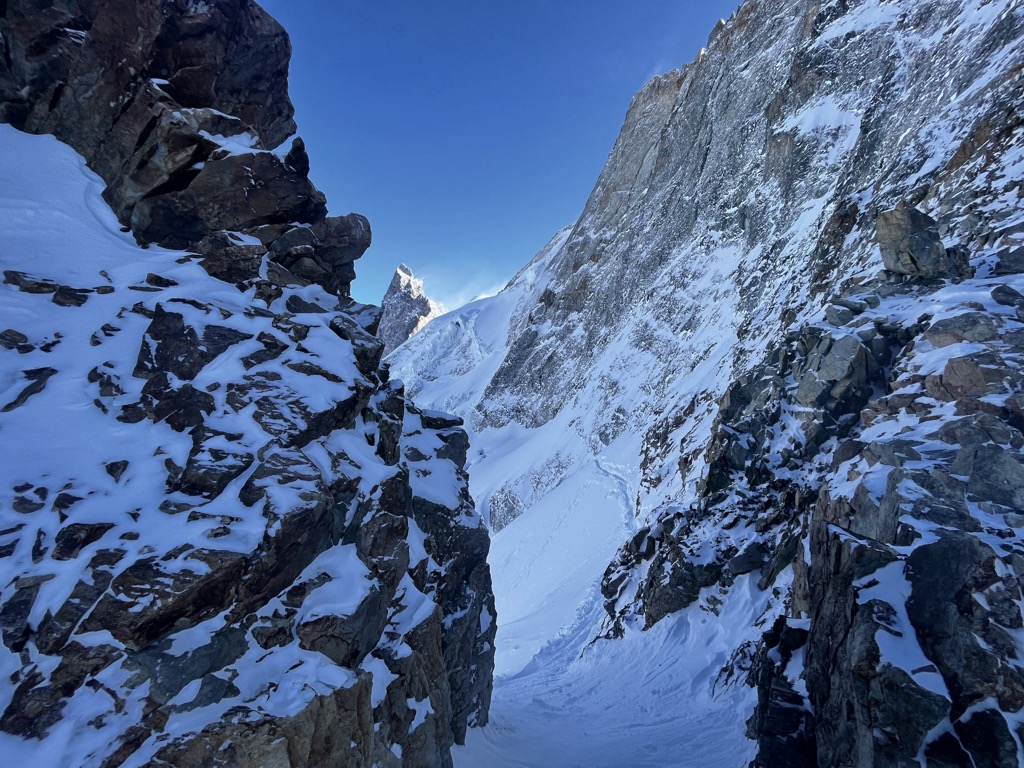
Hire a Guide
Europe has a strong guiding culture, and finding a guide to show you the best spots is easy. Meanwhile, backcountry ski guiding in the States is more stigmatized, and the best places are often fiercely guarded (here’s an interesting article on the subject).
If you can afford it, a guide is a valuable resource. As a result of the international standard for certification, the IFMGA, guides are more professional than ever before. You could say they possess the equivalent of a PhD in the mountains.
Guides know the area they are guiding exceptionally well, often having decades of experience in skiing there. The guiding community constantly communicates about where to find the best snow and can teach you something about movement and safety along the way. Moreover, they can tailor the skiing to your individual or group’s level.
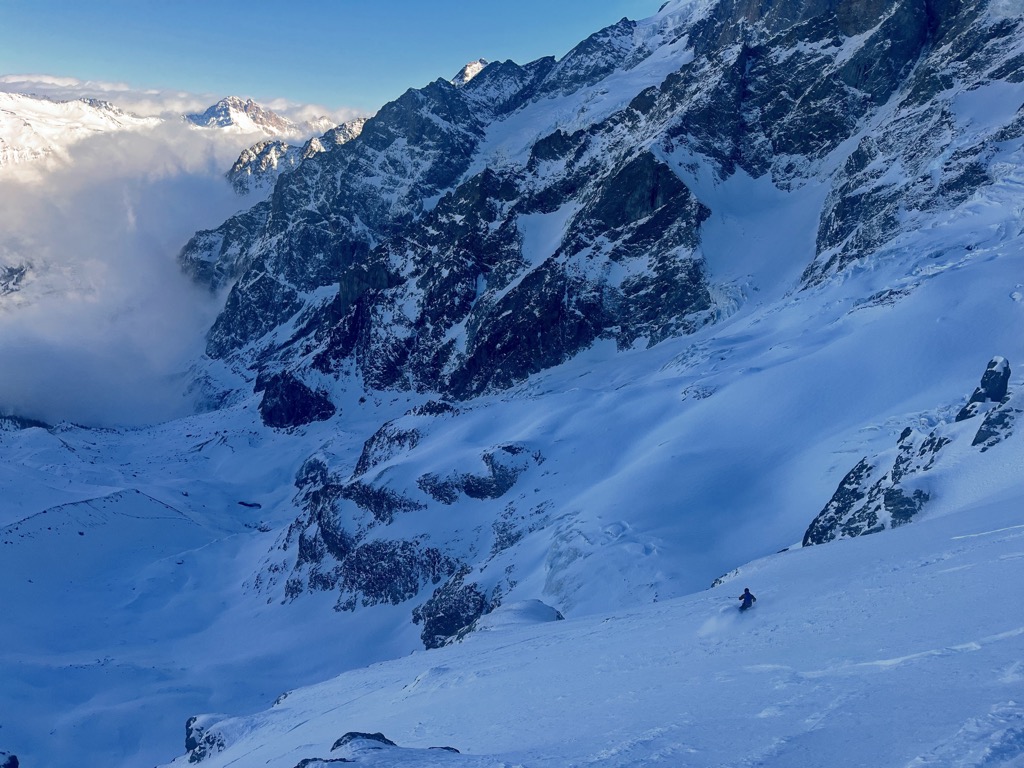
Avoiding Ski Crowds
Skiers and riders will come out of the woodwork and descend upon the mountains when the conditions are ripe. In many cases, resorts and even backcountry areas can become crowded. Crowds are generally detrimental to one’s ability to profit from untracked powder turns. Here are a few ideas for ways to avoid the teeming masses.
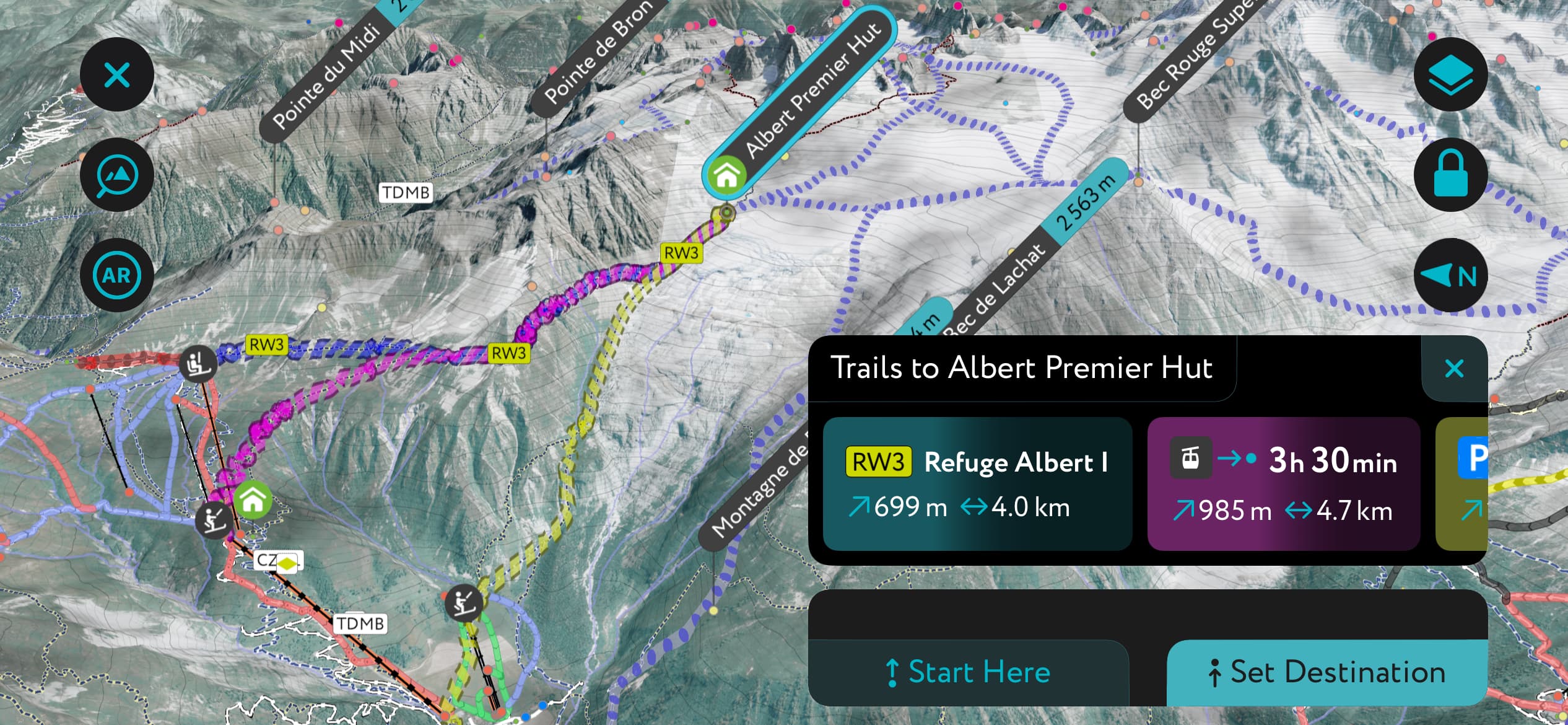
Avoiding Big Ski Resorts
If you’re interested in off-piste skiing, you’ve likely heard of some famous ski areas: Jackson Hole, Whistler, Chamonix, Palisades Tahoe, St. Anton, Alta/Snowbird…the list goes on. The thing is, all of these places are packed with people who want to do the same thing as you. On one hand, these resorts are famous for a reason. They get lots of snow, they’ve got great off-piste terrain and lift access, etc.
However, even in the 21st century, many small, family-style resorts don’t see huge numbers of skiers - especially in Europe. My favorite resource is WePowder’s Guide to the Alps, which provides many incredible photos and a general overview of hundreds of resorts in the Alps, both big and small. I have found some absolute gems in this book.
Avoiding Ski Lifts and Skiing “Lift-access Backcountry”
Lapping ski lifts is a great way to quickly get a lot of off-piste vertical under your belt. However, the untracked stuff is likely a bit further away from the lift. In America, this terrain is often called “lift-access backcountry,” “slackcountry,” or “side-country,” and is delineated by a clear boundary. In Europe, where the resort boundary ends and the backcountry begins is less clear.
Lift-access backcountry is a good way to ski untracked snow without hiking all the way to your destination. It requires more effort than skiing under the lift but not nearly as much as pure ski touring.
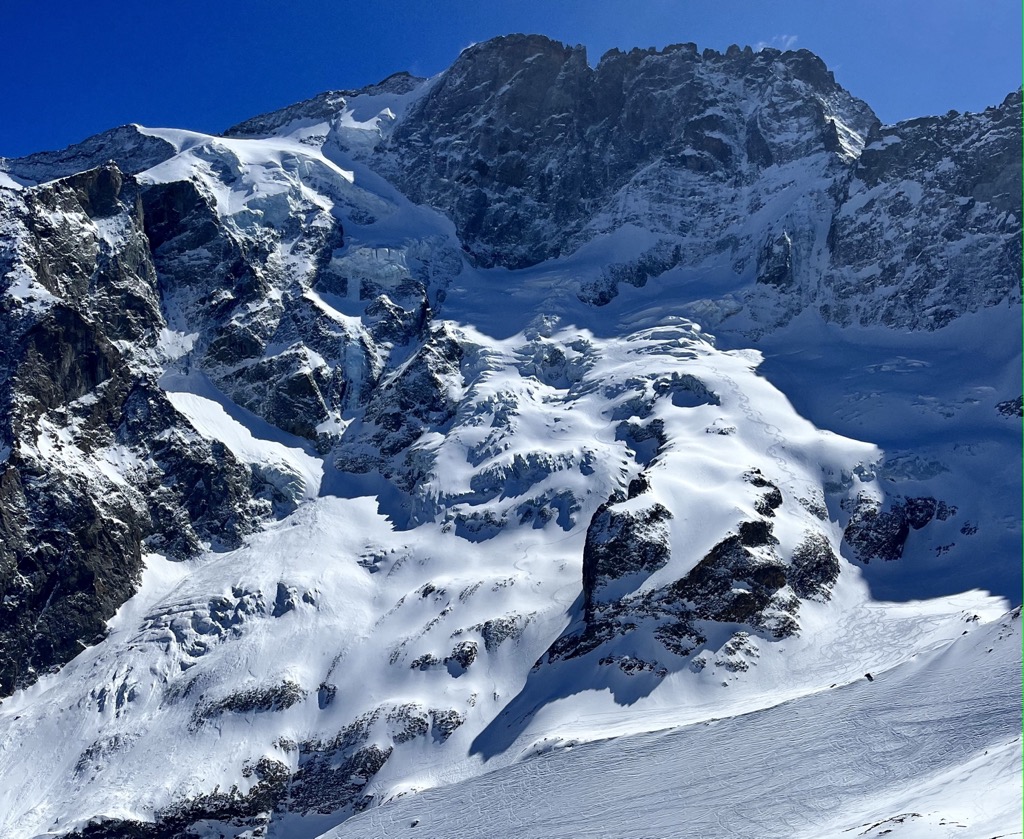
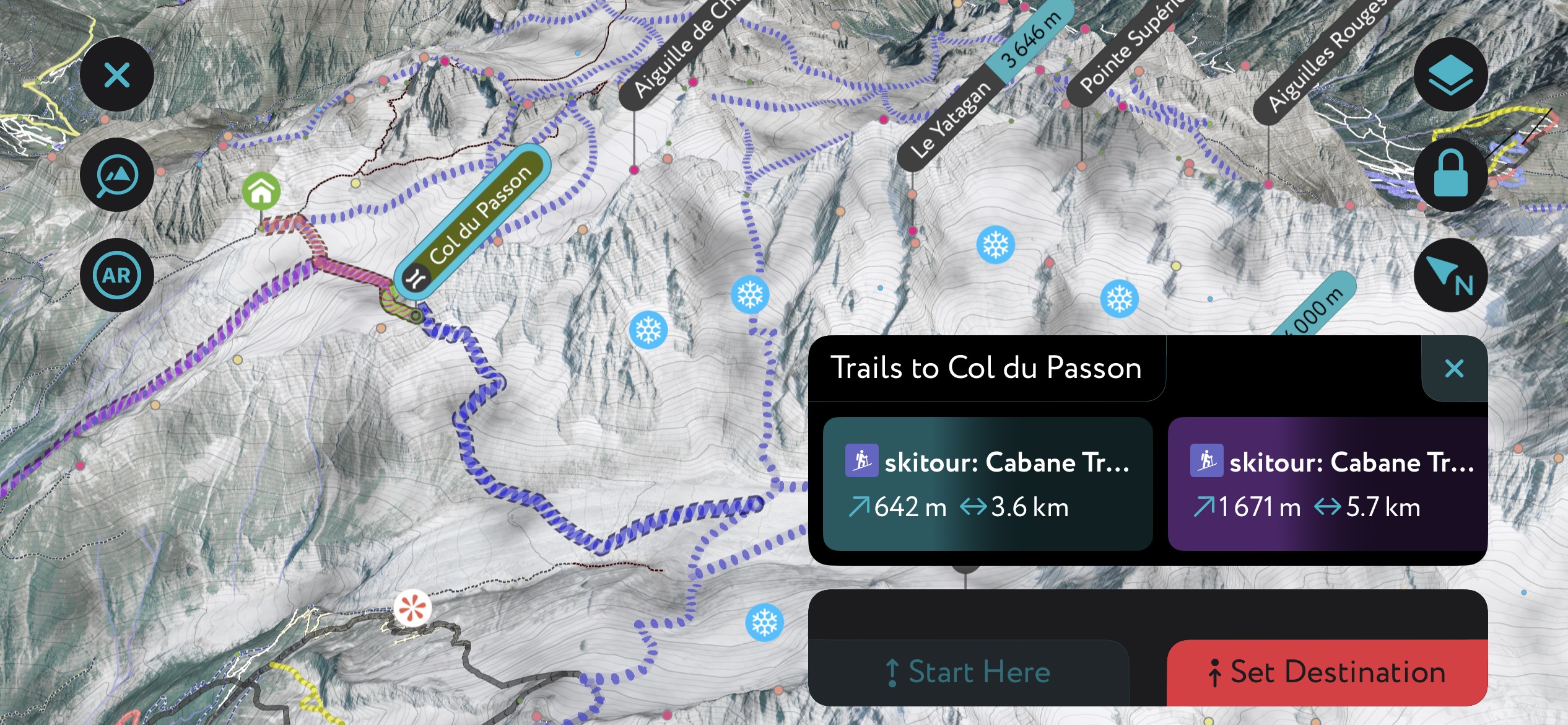
Earning Your Turns
Perhaps the most sure-fire way to secure some powder turns is a jaunt in the backcountry, clear of the auspices of mountain lifts and their clientele.
Backcountry skiing is an entire sport on its own and requires specialized gear and knowledge, as well as some serious fitness. But it’s the purest form of skiing we have, still similar to 10,000 years ago - with the addition of synthetic materials and advanced engineering.
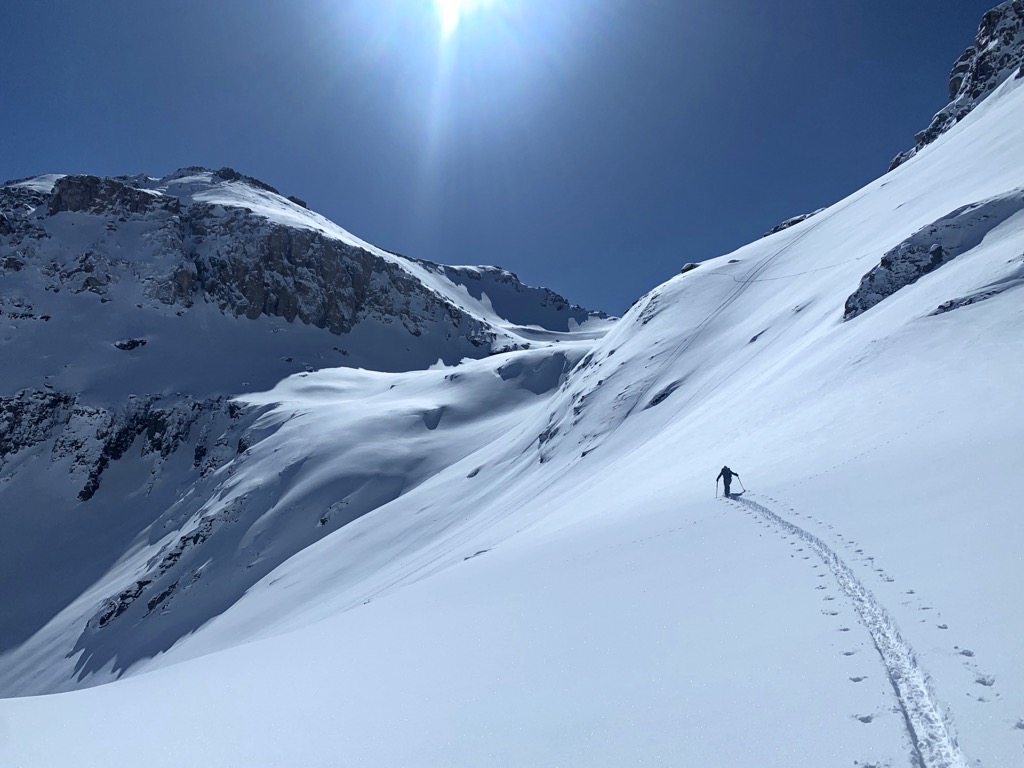
Getting the Most Out of a Powder Day
Powder days are an increasingly finite resource, so making the most of each one is essential.
Early Bird Gets the Worm
The adage couldn’t be more accurate when it comes to powder skiing. Skiers and riders start lining up at their favorite lifts early in hopes of getting the first tracks down their favorite line. Get there early, and be one of them. Plus, you get to talk to your friends in line. Powder days are just so much better when you’re one step ahead of the masses.
Moreover, as soon as that mean old sun pops out above the mountain, it’s fixating its gaze on your powder feast. Sometimes, you’ll get one solid lap before everything turns to mashed potatoes.
However, occasionally, you’ll have a storm day, and the day’s final descent is the deepest. Often, there is nobody on the mountain. This happens a handful of times a season.
Speed and Efficiency
Moving quickly and efficiently in the mountains isn’t just a great way to make the most of your powder day; it’s also essential for safety. Off-piste skiing always involves some sort of objective hazard, and the more efficiently you move through that exposure, the better.
- Make sure you’re in good shape. Skiing off-piste is exponentially more strenuous than skiing on-piste; I watch tourists underestimate this daily at my home ski area. Poor fitness leads to sloppy skiing, which in turn leads to injuries. Getting injured off-piste can often require a helicopter rescue.
- It’s hard to capitalize on untracked off-piste when you’ve got a train of ten skiers and riders to keep track of. Keep your group size down; skiing off-piste with large groups is also a safety hazard. Three to four persons is optimal for speed, but also to have extra hands if an accident occurs, i.e., digging a friend out of an avalanche.
- Organize your pack so you don’t have a gear explosion whenever you open it. Off-piste skiing requires a lot of layering and de-layering since you get much warmer than regular piste skiing.
- Pack your own lunch. You’ll save time and money.
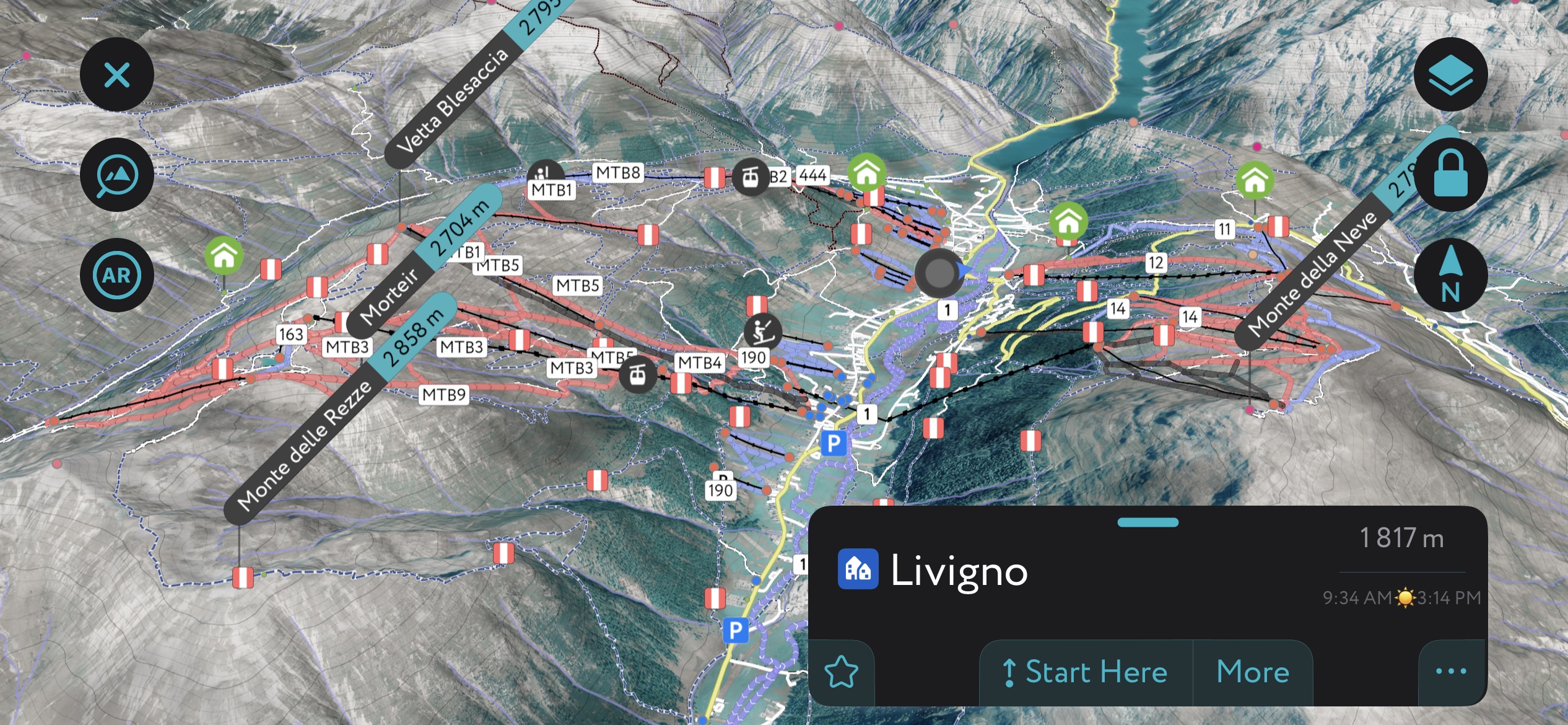

Start Close and Venture Far
Like snowflakes, every powder day is a little different. That said, I usually start with a few quick descents under the lift and then venture further afield as the day progresses. I’ve definitely regretted days where I’ve spent much time finagling around with a big off-piste descent right out of the gate while my friends were lapping powder closer to the lifts.
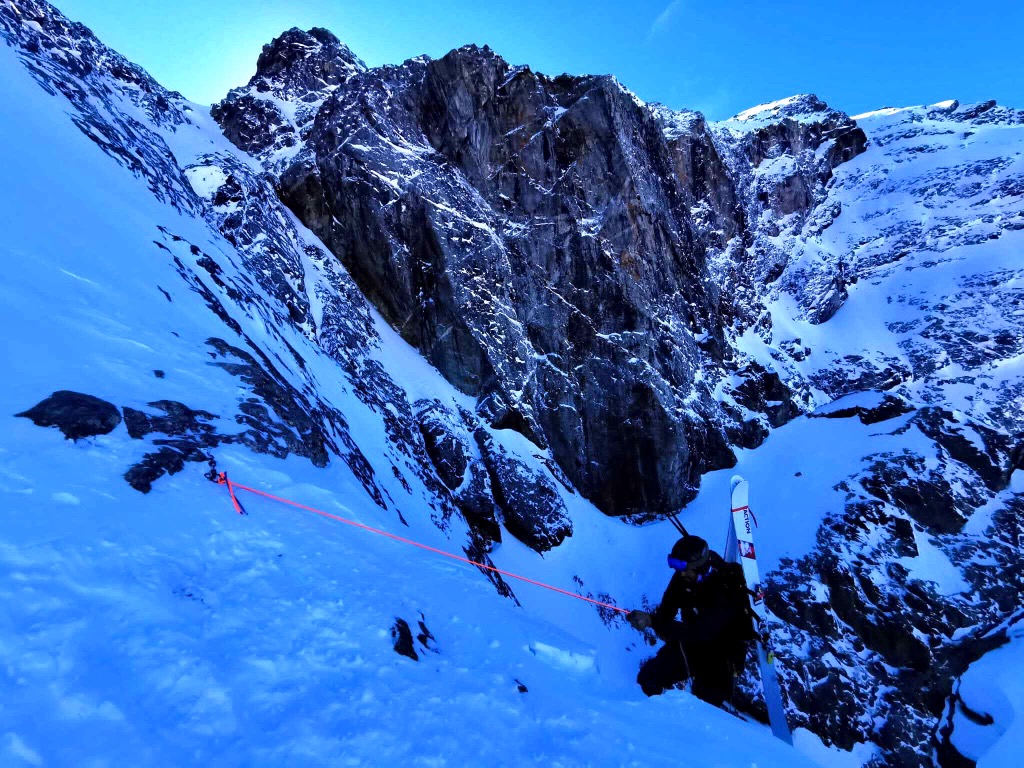
Managing Risk
Even if you’re a well-seasoned expert skier, the electric atmosphere on a big powder day can be overwhelming. You’re riding up the lift, looking at all the lines with loads of fresh powder. Everybody gets off and makes a beeline to their favorite stash.
In times like these, decision-making can be compromised by the anticipation of skiing powder.
It’s yet another reason to step away from the bustle of the big resorts and into the serenity of the backcountry. I always find it’s easier to think and make decisions in the backcountry vs. during the powder rush at a resort.
I won’t get into avalanche discussion in this article. After all, it is a subject that deserves at least an entire book to cover the basics. Stay tuned; I’ll be sure to cover this in a separate article soon.
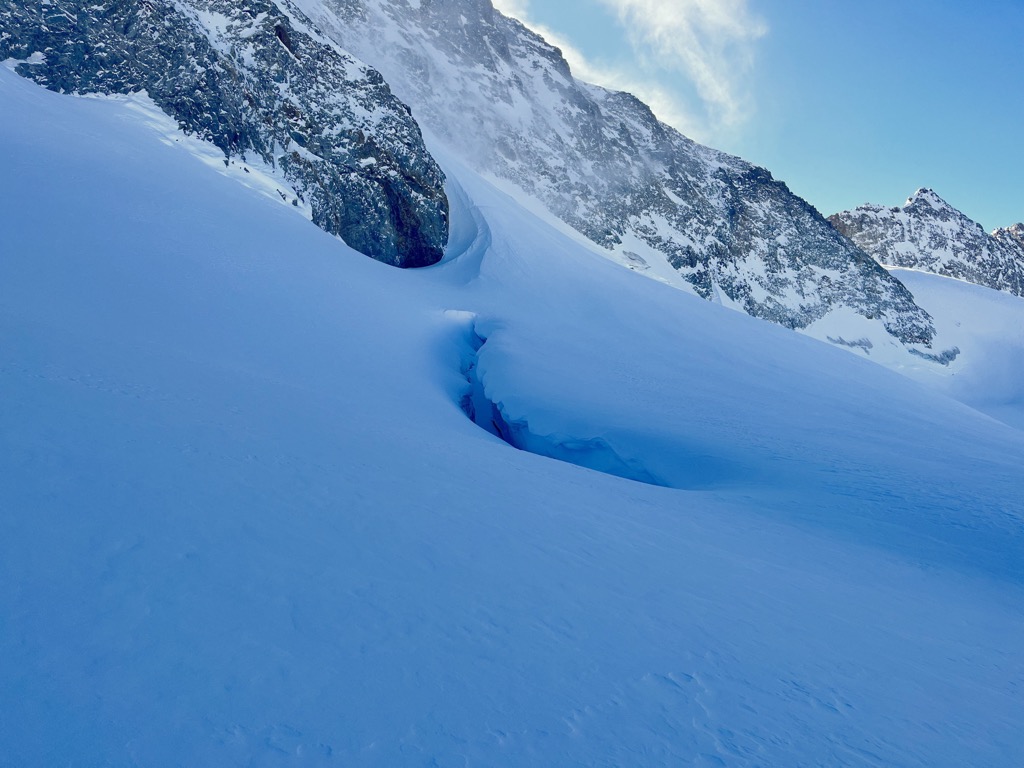
Chasing Storms
In the current era of a rapidly warming climate, I fear that chasing storms is the last remaining way to have a reliably exciting ski season. Otherwise, the norm seems to be sitting through dry spells and scratching your way down a dwindling snowpack. European resorts, in particular, have been feeling the squeeze of a warming world this past decade.
Fortunately, Europe also happens to be the best place in the world to chase storms. Why? Several reasons:
- World’s best lift access to off-piste terrain, including glaciers and full ski mountaineering routes you can’t really find anywhere else.
- The Alps are so big that they block storms from each other depending on the wind direction. It’s common for one region to get hammered with snow while the mountains just a couple of hours away get nothing. Four or five distinct patterns bring snowfall to different sections of the Alps.
- The resorts are closer together so you don’t have to travel as long or far.
- Lift tickets and accommodation are significantly cheaper than in North America. Europe is also super chill about sleeping in a van or vehicle.
- Hundreds of tiny ski resorts become powder meccas when conditions are right (see WePowder Guide).
- There are dozens of unique cultures to experience depending on where you go.
Chasing storms involves weather forecasting, determination, perseverance, and, in the end, luck. It seems like all fun and games until you show up, and the forecast is a bust. Or, it snowed too much, and everything is closed due to avalanche danger. Or your car slides off the icy road in a blizzard. But hey:
“The word adventure has gotten overused. For me, when everything goes wrong – that’s when adventure starts.” - Legendary climber, philosopher and founder of Patagonia, Yvon Chouinard
Those moments when you nail down a chase and have one of the best powder days of your life? They are priceless.
Conclusion
There you have it, folks. Some musings on the beauty of off-piste powder skiing. Don’t forget to check out our app for some of the best tools modern technology has to offer. If you have any comments on the article, please email us at peakvisor@routes.tips! We love hearing from mountain enthusiasts of all sorts.
